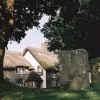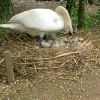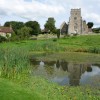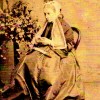One look at the growing crop suggested to William Shipp that something of great significance lay beneath the field. The Blandford Forum man had been called in by the farmer to investigate why the turnips he was growing as fodder for his livestock were withering or yellowing along curiously straight alignments. It was a coarser version of a physical phenomenon more usually seen in hay or cereal crops, but well known to archaeologists as a crop mark, caused when vegetation growing over deeper soil such as that in ditches grows taller and greener than that growing in shallower soil, due to the greater retention of water in the former. The failure of the crop in this way likely meant only one thing: that a large and important building or buildings had once stood where a farmer’s turnip field was now situated.
The field then used to grow turnips was Barton Field, situated in the parish of Tarrant Hinton, one of the Tarrant River Valley group settlements on the southern slope of the chalk ridge overlooking the Tarrant on the western side of the parish. But it is just one of several places in Dorset and southern England much favoured by the Romans for locating their villas (farm estates) or other settlements. The Tarrant valley in particular seems to have been a corridor attracting intense colonisation and farming during the boom periods of Roman Britain in the 2nd and 4th centuries. For example, excavation of another important villa site at Hinton St. Mary, a few miles south east of Tarrant Hinton, revealed a mosaic floor pavement in which was set a motif featuring the two Greek letters Chi & Ro (standing for Christos) behind a representation of Jesus. This depiction, now in the County Museum, furnished evidence of conversion to Christianity among these early Romano-British settlers by the 4th century – over two centuries before St. Augustine’s mission in 597 AD.
What Mr Shipp was looking at that day in 1845 were concealed foundations of one of Dorset’s major Romano-British settlements, agriculturally etched into the failure of the turnip crop. He was later to remark that remains of Roman origin were to be found in every part of this field and it was evident that for many years numerous finds of Roman pottery and coins had been turning up for antiquarians to collect. Early in the 20th century a Mr A, Giles from Tarrant Hinton uncovered an extensive tesserae (mosaic) floor in the field, but apart from this no further serious exploration of the site would be undertaken until the 1960’s.
Fast-forward to 1968, when the then landowners, Messrs E & D Hooper, suspecting that a major archaeological site of the 1st to 4th century once occupied their property, called in two officials on the staff of Dorset County Museum in Dorchester to assess whether a trial exploration should be undertaken. After determining that the mosaic flooring was being ploughed out, the archaeological consultants recommended that a full systematic excavation should be carried out during the field’s fallow periods, for which the Hoopers duly granted permission to proceed.
The subsequent trial excavation commenced in October 1968 and concluded in March 1969. A grid system of trenches spaced at 10-foot intervals was set out in the centre of the field. This revealed a large building later thought to have possibly been the headquarters of a large estate of farms, lying at 45 degrees across the grid square.
Then in August 1969 the Department of the Environment authorised the start of a full-scale long-term excavation. During this dig a complex of about six distinct buildings was exposed, irregularly grouped around a wide open courtyard. It was determined that these buildings extended into the 3rd and 4th centuries. Two of these buildings had a hypocaust (under-floor heating system); though curiously, an absence of soot residue in one of these systems showed that it had never been used. The second of these buildings with a hypocaust was excavated in a fallow area of the north-eastern side of the field while a crop was being grown elsewhere and turned out to be a bath house dating from the 1st century. Unlike the earlier-discovered building however, it was soon evident that this bath house had been in constant use over a long period, as the under-floor space was full of soot. A coin of the 1st century was recovered from the debris near the heating-duct’s entrance. The excavations as a whole did indeed bear out W. Ship’s findings of 1845, for a large amount of coins, pottery sherds and painted wall plaster fragments were recovered from the site.
Nor was it only Romano-British settlement evidence that the Barton field contained. Immediately beyond and adjacent to the two main buildings long the south-west side of the courtyard a small cluster of Bronze Age graves was found. And furthermore, the complex of buildings on the western side had been built over an Iron-Age ditch running west-east through the site.
Documentary research indicated that the Roman settlement was granted to a freedman of Nero called Pompeius Anicetus. Two reference works indicate that this estate was said to have been situated just off the Roman road linking Durnovaria (Dorchester) and Sarum (Salisbury), and north of Vindocladia (Badbury Rings) but approximately half-way between the two town’s population centres. Furthermore, it is known that Pompeius dedicated an altar to the Roman deity Sulis at the Roman baths of Aquae Sulis (the town of Bath). The Barton field settlement also lies adjacent to the Roman road connecting Badbury Rings and Bath near the intersection of the Sarum-Durnovaria road. From a map it can be seen that Tarrant Hinton lies roughly midway between Salisbury and Dorchester, and north of Badbury Rings. Indeed, on a clear day anyone standing on the Anicetus site can clearly see the ancient Badbury earthworks when looking south.
Note: William Shipp was a bookseller trading from Market Place, Blandford Forum. He was baptised on the 28th of March 1807 at Blandford and was the son of John Shipp and Ann Simmonds who were married at Blandford on the 8th of May 1797.
In the first half of 1839 William Shipp married Emily Spooner. Their children were: Amelia (1842); Mary (1844); William (1845); Henry (1847). William died late in 1873, his widow moved to East Street, Blandford Forum.
The 1830 edition of Pigots trade directory has a John Shipp trading as a bookseller from premises in Market Place, Blandford Forum, so it would appear William continued his father’s business.



